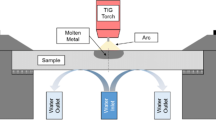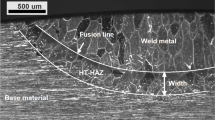Abstract
Arc welding involves joining two metal plates by a welding pool, which is kept molten for short periods due to an electric arc. This weld metal has, sometimes, a different composition from the plates, due to a filler metal. Arc welding is a non-equilibrium process. Technological approach, nevertheless, uses empirical tools to predict important features of the joints. In stainless steel welding, the Schaeffler diagram, and other constitutive diagrams, as the WRC 1992 diagram, are used to predict the resultant microstructure in the welded joint. The composition input is calculated by Chromium and Nickel equivalents expressions. Schaeffler diagram is used to evaluate weldability of stainless steels. Some people adapt the W and N alloying elements in Schaeffler diagram to predict the weldability of duplex stainless steels (DSS). Present work shows how these technological tools can be understood as results of phase equilibrium in key isotherms of the Fe-Cr-Ni system, used in all constitutive diagrams. The validity and limitation of the Chromium and Nickel equivalents expressions were discussed based on the effect of up to two alloying components (X1 = Mo or W and X2 = N) on the alpha/gamma phase equilibrium, as estimated by calculations in system Fe-Cr-Ni-X1-X2 that are typical DSS alloying elements. This allows extending these Chromium and Nickel equivalents expressions based on thermodynamics and to identify vulnerabilities for two important problems in DSS welding: Chromium nitride and sigma phase precipitation. Originally, Schaeffler’s diagram does not consider the effect of W and N in the (γ/α + γ) equilibrium field.










Similar content being viewed by others
Notes
Actually the martensitic transformation depends on other factors, the present calculation only shows that the transformation is possible, as a sine qua non condition.
References
A.L. Schaeffler, Selection of Austenitic Electrodes for Welding Dissimilar Metals, Weld. J., 1947, 26(10), p 1-20
A.L. Schaeffler, Welding Dissimilar Metals with Stainless Electrodes, Iron Age, 1948, 162, p 72-79
A.L. Schaeffler, Constitution Diagram for Stainless Steel Weld Metal, Metal Prog., 1949, 56(11), p 680
W.T. DeLong and H.F. Reid, Jr., Properties of Austenitic Chromium in Austenitic Chromium-Manganese Stainless Steel Weld Metal, Weld. J., 1957, 37(1), p 1-8
C.J. Long and W.T. DeLong, The Ferrite Content of Austenitic Stainless Steel Weld Metal, Weld. J., 1973, 52(7), p 281s-297s
T.A. Siewert, C.N. McCowan, and D.L. Olson, Ferrite Number Prediction to 100 FN in Stainless Steel Weld Metal, Weld. J., 1988, 67(12), p 289-s-298-s
D.J. Kotecki and T.A. Siewert, WRC-1992 Constitution Diagram for Stainless Steel Weld Metals: A Modification of the WRC-1988 Diagram, 1992, Weld. J., 1992, 71(5), p 171s-178s
D.L. Olson, Prediction of Austenitic Weld Metal Microstructure and Properties, Weld. J., 1985, 64(10), p 281s-295s
R.D. Thomas, Jr., A Constitution Diagram Application to Stainless Weld Metal, Schweizer Archiv fur Angewandte Wissenschaft und Technik, 1949, 1, p 3-24
E. Yamamoto, K. Shiga, R. Kayano, T. Okazaki, H. Watanabe, T. Kiso, T. Tahara, and F. Minami, Guidelines for Repair Welding of Pressure Equipment in Refineries and Chemical Plants, J. Press. Vessel Technol., 2013, 135(3), p 034501-034501-12. doi:10.1115/1.4023729
K. Frisk, A Thermodynamic Evaluation of the Cr-Fe-N System, Metall. Mater. Trans. A, 1990, 21(9), p 2477-2488
A.V. Khvan, B. Hallstedt, and C. Broeckmann, A Thermodynamic Evaluation of the Fe-Cr-C System, CALPHAD, 2014, 46, p 24-33
Acknowledgments
The authors would like to thank Eng. Caio de Paula Camargo Pisano (Aperam South America, São Paulo, Brazil) for useful discussion concerning milling of duplex stainless steels. The present work was supported by the Brazilian National Research, Innovation and Development Council (CNPq, Brasília, Brazil) under Project 312424/2013-2, and by the Fundação de Amparo à Pesquisa do Estado de São Paulo (São Paulo, Brazil) under Project 2016/05768-2. This support is gratefully acknowledged.
Author information
Authors and Affiliations
Corresponding author
Additional information
This article is an invited paper selected from presentations at TOFA 2016, the Discussion Meeting on Thermodynamics of Alloys, held September 4-9, 2016, in Santos, Brazil, and has been expanded from the original presentation.
Rights and permissions
About this article
Cite this article
Brandi, S.D., Schön, C.G. A Thermodynamic Study of a Constitutional Diagram for Duplex Stainless Steels. J. Phase Equilib. Diffus. 38, 268–275 (2017). https://doi.org/10.1007/s11669-017-0537-8
Received:
Revised:
Published:
Issue Date:
DOI: https://doi.org/10.1007/s11669-017-0537-8




